Ever heard a loud “kutroo-kutroo-kutroo” echoing through your garden or park and wondered who’s behind the call? Meet the Brown-headed Barbet, a chubby, green-feathered bird with a brown noggin and a big, bold beak. Common in Indian cities, villages, and forests alike, this bird often goes unnoticed — until you hear its persistent, almost woodpecker-like call.
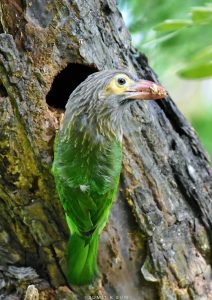
In this article, we’ll get to know this tree-loving, fruit-guzzling resident of India. From its physical traits to its fascinating nesting habits and role in ecosystems, let’s explore the full story of the Brown-headed Barbet.
How to Identify Brown-headed Barbets
🪶 What Does the Brown-headed Barbet Look Like?
| Head | Dull brown with streaks; gives the bird its name |
| Body | Bright green overall, helping it blend into leafy trees |
| Beak | Stout, yellow-orange, slightly curved |
| Eyes | Pale white, very noticeable on the dark face |
| Size | About 27–30 cm long; medium-sized among barbets |
| Tail | Short and square-shaped |
Males and females look almost identical which makes it tough to tell them apart without behaviour clues.
🟢 Pro Tip: Look for movement in tree canopies and listen for loud, rhythmic calls, that’s usually your first clue to spotting one.
Habitat: Where Can You Find Brown-headed Barbets
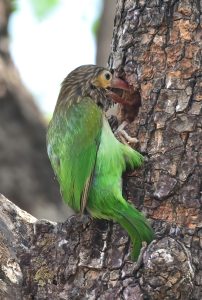
The Brown-headed Barbet is highly adaptable and can be seen in:
| Urban gardens and city parks |
| Orchards and plantations |
| Tropical and deciduous forests |
| Temple grounds and old groves |
It prefers areas with plenty of fruiting trees and is especially common in northern, central, and southern India, including foothills and plains. You’ll rarely find it in arid or treeless zones.
Distribution of Brown-headed Barbets – A True Indian Resident
While it’s found across the Indian subcontinent, its range includes:
| India (throughout, except the arid northwest and high Himalayas) |
| Nepal |
| Sri Lanka |
| Bangladesh |
| Parts of Bhutan |
It’s a non-migratory bird, meaning you can spot it year-round.
Vocalizations of Brown-headed Barbets: The Garden Gong
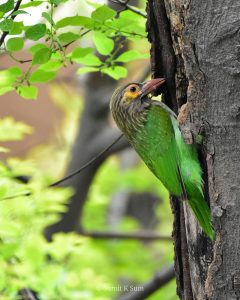
🔊 Calls and Communication
- Signature call: Loud “kutroo-kutroo-kutroo”, repeated rapidly
- Mates often duet in a synchronized pattern
- Calls are usually made from perches high in trees
Barbets vocalize loudly especially during the breeding season and are known to call continuously for several minutes, which sometimes annoys sleepy city-dwellers.
🎧 Related Read: Spotted Owlet – The Tiny Night Guardian — another bird with a distinct and eerie call pattern.
Feeding Habits of Brown-headed Barbets
The Brown-headed Barbet has a frugivorous diet, but will occasionally eat insects too.
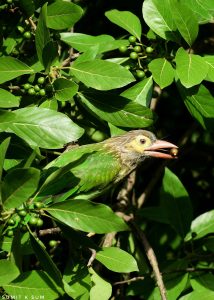
🥭 Favorite Food:
- Guava
- Mango
- Jamun
- Figs (Peepal, Banyan)
- Papaya
- Banana
- Berries and wild fruits
🐛 Occasional Snacks:
- Caterpillars
- Beetles
- Termites
They play an important ecological role as seed dispersers, helping trees regenerate.
Suggested Read: Learn about another urban fruit-eater in our article on the Indian Peafowl – The Pride of India.
Nesting and Breeding among Brown-headed Barbets – Architects of the Trees
Brown-headed Barbets are cavity nesters, meaning they excavate holes in tree trunks for nesting.
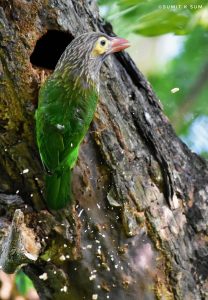
🪺 Nesting Facts:
- Both sexes chisel out the nest hole in softwood trees
- Nest is a tunnel-shaped cavity 3–5 feet above ground
- Lays 2–4 white eggs
- Incubation: About 14 days
- Chicks fledge in 3–4 weeks
They prefer older trees with softer wood, making native trees like neem, mango, and banyan excellent nesting options.
🌿 Also Read: For another cavity nester, check out Indian Pitta – The Monsoon Visitor, known for nesting in low shrubbery during monsoons.
Brown-headed Barbets’ Behavior and Ecology
| Often seen perched quietly on bare branches |
| Walks and hops rather than flying long distances |
| Usually solitary or in pairs |
| Territorial during breeding season |
| Prefers the upper canopy, though ventures lower to feed |
Cultural and Local Significance of Brown-headed Barbets in India
📜 In Indian Folklore:
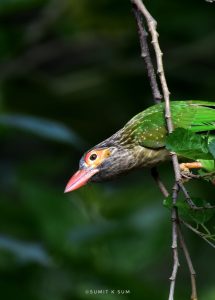
- In South India, it is known as Kottan, derived from the knocking call it makes — locals once believed it was a tree spirit calling out.
- In parts of West Bengal, farmers welcome its calls in mango orchards, believing it brings fruit abundance.
- In rural Maharashtra, its presence in groves is seen as a sign of ecological balance.
Barbets are often overlooked in myth, but their association with fruit trees has earned them a quiet reverence in agrarian communities.
Conservation Status of Brown-headed Barbets: Still Safe, But Watchful
The Brown-headed Barbet is classified as Least Concern (IUCN) — but it faces pressures due to:
- Loss of mature fruiting trees
- Urban pruning and deforestation
- Competition for nesting sites with other birds and mynas
- Pesticide use affecting their food sources
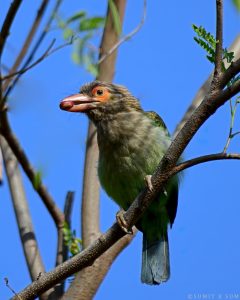
✅ What You Can Do:
- Plant native fruit trees like jamun, mango, and banyan
- Avoid pesticide use in gardens
- Leave dead or aging trees where safe — they’re nesting goldmines!
- Raise awareness about cavity-nesting birds in cities
Fun Facts About Brown-headed Barbet
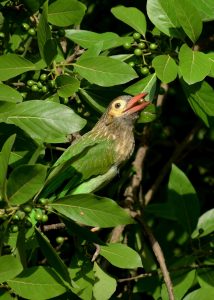
- Despite the resemblance, they are not related to woodpeckers
- Their tongues are bristly, perfect for scooping fruit pulp
- They sometimes roost in their old nests during monsoons
- Known to bathe in rain by flapping wings under wet leaves
- Barbets belong to the Megalaimidae family, unique to the Old World
🪶 You May Also Like
| Purple Sunbird – The Shimmering Pollinator |
| Common Kingfisher – The River Jewel |
| White-throated Kingfisher – The Blue Bolt |
| Get your favourite Brown-headed Barbet photograph framed for your wall – Request Now @+91-9540178459 |
